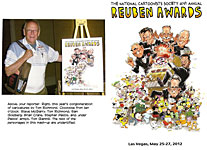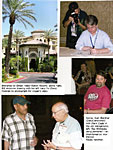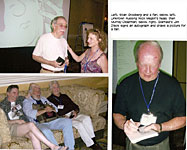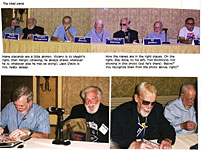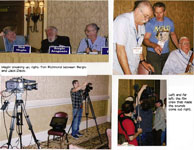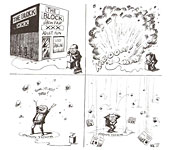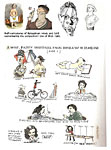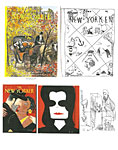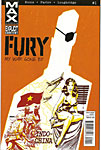 |
|||||||||
Opus 294 (June 2, 2012). With this Bunny Bonus, we commit a report on the Las Vegas convention of the National Cartoonists Society and list all the Reuben winners anointed there. We also report on an editorial cartoon that had Real Impact on the Real World, review Blown Covers, the book of rejected (and tantalizingly provocative) covers for The New Yorker, and comment briefly on the first issues of Valiant’s X-O: Manowar and Fury Max —in that order, starting forthwith—:
CARTOONISTS IN CARTOON CITY The Usual Sardonic Report Announcing This Year’s Crop of Reuben Winners Las Vegas is
the ultimate American cartoon city. Like a good cartoon, everything about it
is exaggerated. It’s excess to the nth instant. It’s all bright lights, they
say, but it’s not just lit up: it’s throbbing with light, everywhere you look.
Its hotels are not merely luxurious: they’re self-consciously opulent, and in
the greed of their giddy grab at opulence, they’re also tacky tacky tacky.
Nothing is simply realistic in Las Vegas. Because everything is exaggerated,
everything is therefore cartoony. And in its very function as the gambling
capital of the United States, Las Vegas is a caricature of the country. It is a
caricature of capitalism: gambling satirizes capitalism’s animating impulse to
make as great a profit as possible from as little investment as possible. As
caricature city, Las Vegas is the perfect place for a bunch of cartoonists to
hold a meeting. And so they did. The National Cartoonists Society conducted its 66th annual Reuben Awards banquet in Las Vegas over Memorial Day weekend, May 25-27, at the Green Valley Ranch Resort. Although the awards distributed at the Saturday evening banquet constitute the irrefutable high point of the Society’s annual convention, the preliminaries are usually instructive and often thought-provoking. These one-hour program events are called “seminars” even though they are all formal presentations by individual cartoonists, who rehearse their professional biographies and discuss their work, projecting pictures on a large screen in front of a respectful audience. Here’s a rundown on this year’s offerings. On Friday, Mark Simon (cartoonist, producer, director, writer, lecturer and entertainment industry expert) explained energetically (occasionally hopping onto an empty chair in the audience) that any publicity a cartoonist gets is the equivalent of free advertising. Agreed. But he failed to explain how to get the publicity. Or maybe I just didn’t hear that part. In my usual half-deaf state, I typically hear only about every other word; but at the NCS events this year, the sound system was so out-of-whack that no one heard very well. (I realize that I may be just projecting here, but I’m arriving at this conclusion based upon the number of normal-eared persons who asked me, unprovoked, if I thought the sound was bad.) After Simon came Michael Jantze, Dave Kellett, and John Lotshaw who discussed the future of cartooning—chiefly, the Internet and self-publishing. Animator Butch Hartman was next, talking about his work on the Nickelodeon series “The Fairly Odd Parents,” “Danny Phantom” and “T.U.F.F. Puppy.” Then Curtis’ Ray Billingsley showed a short film about his life and work (his professional life began while he was still in his early teens—or maybe, even, just eight years old, if I remember aright) and spent the remainder of his time pacing back and forth on a small stage (platform) regaling us with amusing incidents from his life and career. The weekend’s ritual preliminaries reached their half-way pinnacle late on Friday night, when cartoonists abandoned all sense of their proper roles in civilized society to participate in a raucous karaoke, which I usually avoid in order to preserve what is left of my ear drums. On Saturday, Stan Goldberg (who would be ushered into the NCS Hall of Fame with the Gold Key Award that evening) kicked off the afternoon’s presentations with the story of his career, mostly with Archie but not exclusively. And Garfield’s Jim Davis continued in the same vein but with considerably more antics, exaggerated gesticulation and waving of arms. That evening, we all convened to consume cocktails before the final festive throes of the Reuben Banquet at which the awards are dispensed. But the hour of liquid refreshment is postponed for a 90-minute interval without programming so that those in attendance may perfect their attire for the evening: by tradition and decree, the Banquet is a “black-tie” affair, and tuxes and formal gowns abound. The original intention of the formal dress fiat, proclaimed in the mid-1950s, was to infuse dignity into the occasion—to demonstrate, for any who might be interested, that cartoonists were not slovenly unshaven attic-dwellers but normal human beings. In short, the Banquet as it evolved was viewed as a showcase for the profession: cartoonists were on display. This justification for impersonating penguins disappeared several years ago: since neither the public nor the press is welcome at the Banquet, the display of cartooner dignity no longer serves any purpose. The only people to witness cartoonists in tuxedoed dignity are other cartoonists, who, as a breed, recognize fraud when they see it.
FOLLOWING THE LIBERATING LIBATION HOUR, we all sat down to dinner, after which came the evening’s entertainment, which, like the afternoon presentations, was distinguished by a poor sound system (too much treble, too little base, and speakers ratcheted up too loud for the hardware). Master of ceremonies Tom Gammill, his third time at bat, began with a monologue featuring him pacing back and forth across the stage in his persona as a clueless wannabe cartoonist, mumbling witticisms that, because of the lame sound system, we couldn’t hear. After ten minutes of this, laughter started to wane. And Gammill eventually surrendered the podium to a parade of presenters who presented. The first award was the Silver T-Square for service to the profession, presented to past prez Steve McGarry, a fugitive Brit, whose chief contribution to the profession, as far as I can tell, was as NCS prez when he instituted the Friday evening karoke. He also presided over the formation of the NCS Foundation, which absorbed the vintage Milt Gross Fund that had been set up to help indigent cartoonists. But his first act as prez was to endorse the demise of National Cartoonist Day on May 5, the anniversary of the Yellow Kid’s most flamboyant appearance in the New York World. Cartoonist Day had been established only a few years before by NCS but was running into serious and overwhelming competition by Cinco de Mayo, so McGarry announced that we’d give up Cartoonist Day rather than co-exist with Cinco de Mayo. He may have talked about these achievements in his acceptance speech, but I can’t say: couldn’t hear. Stan Goldberg was next: receiving the Gold Key Award, he told how he was inspired to become an artist. Couldn’t hear that either. After that, came the Reuben “division” awards, plaques awarded for achievement in the various genre of cartooning. The jurying for the Division Awards is accomplished by the NCS chapters, whose members select in the assigned category three finalists, of whom one is chosen as the winner (his/her identity kept secret until the Reuben Banquet). All the finalists appear as nominees in the months before the awards are presented, and because being nominated for any of these awards is a distinction in itself—the considered judgment of one’s peers—I’m listing here the nominees as well as the winners in each division, identifying the latter with an asterisk before their names; those with two asterisks were not present to receive their awards. Newspaper Comic Strips—**Glenn McCoy, The Duplex; Steve Kelley and Jeff Parker, Dustin; Mike Peters, Mother Goose and Grimm; Newspaper Panel Cartoons—*Mark Parisi, Off the Mark; Stephanie Piro, Smile; Wiley Miller, Non Sequitur; Magazine Gag Cartoons—Mathew Diffee, **Zach Kanin, Barbara Smaller (all New Yorker cartoonists); Editorial Cartoons—Lisa Benson, Mike Lester, *Mike Ramirez (all conservatives); Comic Books—Darwyn Cooke “Betty Saves the Day” in Rocketeer Adventures no. 2; Duncan Fegredo, Hellboy: The Fury; **J.H. Williams, Batwoman; Graphic Novels— Chester Brown, Paying For It; Rick Geary, The Lives of Sacco and Vanzetti; **Ben Katchor, The Cardboard Valise; Online Comic Strips—Matthew Inman, The Oatmeal; Mike Krahulik and Jerry Holkins, Penny Arcade; *Jon Rosenberg, Scenes from a Multiverse; Television Animation—Ben Bocquelet and Antoine Perez, Production Design on “The Wonderful World of Gumball,” Cartoon Network; Penn Ward, Character Design on “Adventure Time,” Cartoon Network; **Erik Wiese, Production Design on “The Mighty B,” Nickelodeon; Feature Animation—**Mark McCreery, Character Design, “Rango”; Carlos Saldanha, Director, “Rio”; Jennifer YuhNelson, Director, “Kung Fu Panda: The Kaboom of Doom”; Newspaper Illustration—Glen LeLievre, Michael McParlane, *Bob Rich; Greeting Cards—Dave Klug, **Glenn McCoy (in his second win and non-appearance of the evening), Rick Stromoski; Magazine Feature/Magazine Illustration—Victor Juhasz, Bruce McCall, **Edward Sorel; Book Illustration—Barbara Lehman, The Secret Box; Mark Pett, The Girl Who Never Made Mistakes; **John Rocco, Blackout; Advertising Illustration— *Nick Galifianakis, Kevin Kallauger (KAL), Tom Stiglich. When I announced the nominees last month, I mentioned that Steve Kelley, who writes Dustin, was not mentioned, but that, as it turns out, was only on the listing at the NCS website; elsewhere (wherever?) and in the program for the Reuben Banquet, he was coupled with his partner, Jeff Parker. (Parker was, in effect, nominated twice in the same category because he draws Mother Goose and Grim over Mike Peters’ rough pencils.) It still seems strange to me that there are, in the NCS universe, no magazine gag cartoonists published anywhere but in The New Yorker. And not a single liberal editoonist is worth mentioning. But still—nits picked—where else are any of these cartooning endeavors suitably honored? It seems worth noting, however, that 9 of the 14 Division Award winners (well, eight because one person, Glenn McCoy, won twice) weren’t there to receive their awards. The no-show factor has been operative at the Reuben Banquet for several years, and this year, in anticipation that it would re-occur, a man costumed as Elvis “accepted” for the absentee winners. Nice flamboyant touch in a Vegas venue. The consistently high number of no-shows suggests that in certain niches of the cartooning cupboard, NCS’s awards are not valued highly. Tempting as it may be to jump to that conclusion, a more likely explanation is that in a faltering economy, cartoonists, traditionally among the nation’s poor, can’t afford the luxury of the Reuben Weekend. Still, perhaps NCS has worn out its welcome in the more distantly related realms of cartooning endeavors. Animators, f’instance, might prefer to get an Oscar rather than a Reuben. The increasingly long list of “divisions” suggests the extent of a growing contretemps (if that’s what it is), but the advent of the Web and webcomics takes the dilemma to a galaxy far far away. Is anyone who “publishes” a cartoon on the Web a cartoonist? Is there a certain minimal dexterity with pen or pencil that makes a cartoonist a cartoonist? Or not? Perhaps, as Roy Doty suggested during the annual NCS business meeting, we’ve gone too far and included too many. Doty, avuncular and rumpled and sometimes ironically albeit smilingly caustic, customarily enlivens the business meeting by lodging some far-fetched complaint or another. “Far-fetched” but usually dead on. This year, in a satirical mood no doubt, Doty suggested that membership in NCS be confined to those who draw on paper. Such a criterion would, without quibble, eliminate many of the membership and Division Award confusions. It would remove those who animate by drawing on celluloid; and those who never use paper but resort with ever-multiplying dedication to the digital drawing board. Nicely definitive, Doty’s scheme—clean, clear-cut, quibble-free. Definitive. But it’s probably too late for simple solutions. By the time simple solutions surface, it’s almost always too late for them to be applied.
THE FORMAL CLIMAX OF THE EVENING was the presentation of the Reuben, the name of the trophy given to the “cartoonist of the year.” The official name of the winner in this competition is “best cartoonist of the year” or “outstanding cartoonist of the year.” But that designation has always irked me. As a purely semantic matter, “best/outstanding cartoonist of the year” implies that the recipient has done something in a given year that levitates him above his peers that year. For most of those who’ve won the Reuben, that’s scarcely true. Mostly, the Reuben is conferred upon a cartoonist whose work has been consistently of a high caliber, year after year, without distinguishing one year’s achievement from another’s. Hence, in my lexicon, “cartoonist of the year” NOT “best cartoonist of the year.” The
trophy itself, a heavy metal statuette, was named in honor of NCS's first
president, Rube Goldberg, and the trophy was pure Goldberg. “If you have been influenced by Freud, you might say that the Reuben represents four cartoonists who hated their mothers for allowing them to become cartoonists and [who grope] for an acrobatic answer to the question of why sculptors and pretzel makers have so much in common. Or you might say that the Reuben represents the people of the world striving for a perfect balance to escape the same fate as the leaning tower of Pisa. You'd be wrong on both counts. The Reuben is pure fantasy, including the bottle of India ink that Bill Crawford placed on the posterior of the top man to give the design a little more symmetry. If the Reuben has an underlying significance in its present form, I will say that I created it to keep it from looking like a golf trophy, an Oscar, or a statuette presented to Miss Kitchen Utensils of 1953. My only hope is that each recipient will look upon it as a symbol of the admiration and love of his fellow cartoonists.” But Goldberg's explanation was just another of his inventions. He didn't create the sculpture to serve as the NCS award: when he made it, he thought he was making a lamp. The light bulb screwed into the aforementioned posterior of the uppermost figure. Happily, fellow cartoonist Crawford saw this objet d'art in Rube's home at just about the time the Society was looking for a trophy to present to the “cartoonist of the year,” and he recognized at once that Goldberg's lamp was destined for greater things. He substituted a bottle of ink for the light bulb and made a cast for the trophy. The first to receive the Reuben in all its glory, trophy and fanfare, was the sports cartoonist Willard Mullin in 1954. Rube received the trophy named for him in 1967, three years before he died. This year’s nominees for the honor were Stephan Pastis (Pearls Before Swine), Brian Crane (Pickles), and Tom Richmond (Mad caricaturist; and current prez of the club). Richmond won. Apart from his caricatures, Richmond is known for his massive biceps, and he amused us all in his acceptance speech by doing several curls with the Reuben trophy, treating it as a dumbell that he could lift repeatedly to enhance even further the girth of his upper arm. Pastis didn’t attend the festivities; but Crane did. The evening’s events included a few somber moments while the faces of cartoonists who have died in the last year were projected on a screen in the darkened room. The sequence is introduced by the words “In Memorium” on the screen. For several years, Keith Robinson has pointed out to NCS officialdom that “Memoriam” is the correct spelling of this definitive term; to no avail, apparently. Oddly, the American Heritage Dictionary, 4th Edition, doesn’t list either term, so I suppose NCS officialdom is within the bounds of propriety. But on the Web, we can find the admonishment that “Memoriam” is the correct rendering of the Latin term.
HIGH POINT OF THE WEEKEND was the Sunday afternoon panel of Mad cartoonists. It was the high point because the sound system worked beautifully for it. A half-dozen microphones were arrayed before the panelists—Sam Viviano, Nick Meglin, Sergio Aragones, Jack Davis, Don “Duck” Ewing, Al Jaffee, Ray Alma, and Tom Richmond—and we, the attentive audience, could hear every word. The sound system worked because the proceedings were being videotaped by a film crew that doubtless brought its own microphones. Another mic in the room—the standing microphone for audience members to use in posing questions—provided lousy sound. But the film crew’s mics worked. As intended. Viviano and Meglin traced the history of Mad, passing the narration off to successive Mad men, who, when the history reached their advent at Mad, told of how that had been achieved. Sort of. There were numerous memorable moments. One occurred when Jaffee explained how he first created the enduring feature “Snappy Answers to Stupid Questions.” He was up a ladder to fix the tv antenna on the chimney on the roof of his home, he said—terrified of heights—when he heard or felt footsteps behind him. Someone was ascending the ladder, endangering his perilous perch. Jaffee quaked in fear. At last, the footsteps ceased and he heard his ten-year old son say: “Where’s Mommy?” Faint with a temporary flush of relief, Jaffee responded: “I’ve killed her, and I’m stuffing her body down the chimney.” Later, he developed the experience into the classic “Snappy Answers” feature. The first one, he remembered, depicted a car that had crashed into a tree. A passerby asked the driver: “Have an accident?” “No, thanks” said the battered driver, “—I’ve already had one.” On another occasion, Meglin was demonstrating his affection for Sergio by reaching over to him (they were seated next to each other) and kissing him on the forehead, exclaiming, “We’re very close, dear friends.” Whereupon, a young woman in the audience stood up and claimed they were her parents. Meglin was so impressed by this bit of extemporaneous comedy that he doubled over with laughter and nearly fell off his chair. It was several minutes before the panel could resume its agenda. (It might not have been extemporaneous: could have been staged. Still funny, though, regardless.) The day ended with another cocktail-and-heavy-hors-d’oeuvres event, again celebrating the 60th anniversary of Mad. When we arose the next morning, it was all over. Before we leave the premises, however, let me make it clear that nothing I have said in my customary sardonic tone of voice should be interpreted as disparaging the achievements of the cartoonists who were nominated for NCS awards. (I assume the belittling manner merely for the purpose of avoiding what would otherwise be tones of excessive self-indulgence and glorification in this report.) This year, as in most others, the list of nominees includes highly accomplished practitioners of the arts of cartooning. Not a slouch, I would say, among them. Each of them deserves his/her nomination; and any of the nominees in any category would likewise deserve to win. They’re all that good. Beyond that, we should also celebrate the NCS itself: it is a joy and a delight to witness a professional organization, whose members individually are usually in life-or-death commercial competition with each other, taking some time to recognize the superior work of some of its members. When the Society was founded in 1946, there were those who said it would never last because its premise was flawed. The cartoonists who started the club were mostly syndicated cartoonists and therefore competing for the same limited space in newspapers, and the expectation that this essentially antagonistic bunch would band together under friendly terms was, obviously, delusional. That was 66 years ago, and the club is still plugging happily along. To conclude, here are some of my photographs of aspects of the festivities.
Post-Mortii Odds ’n’ Addenda In Opus 293, the most recent incarnation of Rancid Raves, we inadvertently left out of the first posting two pictures of the paperback book covers that were the chief subject of the segment on Something Completely Different. Perhaps by the time you read this, we’ll have corrected the oversight; so you can return to Op. 293 and re-read the deathless prose of that segment, all of which will make much better sense with the illustrations included. In another vicinity, under Newspaper Comics Page Vigil, I made an approving fuss about a week’s worth of Mutts in which a highly condensed rainstorm re-appeared day after day. I mistakenly said the week in question occurred in May. Not so: it was April 2-7. And I should have made it clearer, I ween, that the Blondie strip of April 7 was included in the line-up of Mutts’ rainy days because Blondie, too—on the very day the Mutts sequence concluded—dealt with inclement weather. In effect, it seemed that Blondie was in cahoots with Mutts for the purpose of the gag. So—go back and read that again, too. In an even earlier posting, Opus 292, during a discussion about the future of syndicated editoons and comic strips, I suggested that the small town newspaper market was not being adequately explored, and I referred to Daryl Cagle, saying he’d been trying to sell this market for years but that it isn’t as fruitful as reasonable analyses would suggest. Some activity, yes; but no bonanza. Wrong. I was simply misremembering. During the Reuben Weekend in Las Vegas, I asked Cagle again about the viability of the small town newspaper market for syndicated sales, and he said it was a good market. Not huge in dollars perhaps, but huge in scope. Of the roughly 1,400 daily newspapers in the U.S., only 275 are published in metropolitan areas with populations of 100,000 or more. All the rest—about 1,100—are published in “smaller” cities and towns. And that makes the newspapers in small cities and towns a good market. Incidentally, Cagle also pointed out that while the number of full-time staff editorial cartoonists has declined from 101 in May 2008 to 60-65 today, representing a 35-40% decline, the supposed high point in the full-time staff editoonist roster, roughly 150, represents slightly less than 11% of the total possible staff jobs in the nation’s daily newspapers. And 60-65 is 4-4.6%, a decline of only 5.4-6%, a much happier statistic than the one I usually cite. And, speaking of happier occurrences, there’s this—:
THE POWER OF POLITICAL CARTOONING MOST EDITORIAL CARTOONISTS believe that their essential function in the political milieu is that of cheerleader: they’re read and appreciated mostly by those who agree with them, and those readers derive satisfaction—and renewed dedication to their cause—by reason of witnessing a cartoon that ridicules those of opposing beliefs. In short, very few editorial cartoonists draw cartoons with the expectation that their cartoon will change the world or, even, the way one or two persons think. Despite this gloomy outlook, all editoonists know that some of their fellows at one time or another in one place or another affected social or political change because of a cartoon they’d drawn. The usual example is Thomas Nast, whose barrage of cartoons about New York’s corrupt government, led by Boss Tweed, eventually so embarrassed Tweed that he bundled up his graft money and left the country. And the legend is that it was a cartoon about him that resulted in his arrest in Spain, the country to which he fled. Police there recognized him from Nast’s pictures. Jay N. “Ding” Darling is another instance of an editooner whose cartoons made a difference—although perhaps not as directly as Nast’s. A passionate conservationist, Ding often cartooned against the depredations of against wildlife and the environment, becoming so visible an advocate nationally that he was named chief of the Bureau of Biological Survey in 1934 and rejuvenated its public relations programs about conservation. Subsequently, he was a founder of the National Wildlife Federation. A hunter himself, Ding was as eager to preserve wildlife for sportsmen as for those who simply enjoy nature. (Incidently, a new book about Ding is freshly available from the Ohio State University Billy Ireland Cartoon Library & Museum: Iconoclast in Ink: The Political Cartoons of Jay N. “Ding” Darling by noted cartoon historian Richard Samuel West is $24.95 plus p&h at cartoons@osu.edu.) Despite the successes of these legendary social workers, most editoonists are content to lead the cheers. But every once in a while, one of this inky-fingered fraternity makes an impression that has an actual result. Kevin “KAL” Kallaugher is one such. In recounting his recent experience of the last week in May, KAL begins modestly enough: after nearly 20 years at the Baltimore Sun before being laid off in one of the many cost-cutting frenzies infecting newspapers, he didn’t think an individual political cartoon could matter. But he changed his mind, as you’ll soon see—:
I LEARNED A SURPRISING TRUTH this week [KAL begins]. I learned that cartoons matter. This may sound funny from someone who has been immersed in the dark art of editorial cartooning for over three decades. Sure—I always hope any cartoon I draft is going to rock the world and be positive force for change. But it is more realistic to assume the daily cartoon is a small voice that affects things in small ways. [As a result,] I believe the cumulative impact of hundreds of cartoons over years can give a cartoonist potent voice in the political discourse. But one cartoon making a difference these days? I didn’t think so—until this week. The cause for change was an essay published this week by former Baltimore Mayor Kurt Schmoke. He had been invited with over a dozen Baltimore luminaries to pen a tribute to the Baltimore Sun in honor of the publication’s 175th anniversary. In his reflection (see below) he chose to describe the influence of a newspaper on local politicians. He gave as the perfect illustration (pun intended) of this power—the editorial cartoon. He cited how one cartoon in particular from 1992 changed his mind and policy on a certain city issue. It was very interesting for me to learn of this, even 20 years after the fact. I now wonder if any other cartoons might have had similar impact on other politicians. For those who don’t think newspaper cartoons have impact, please take note. I now have proof to the contrary, to wit—:
HERE’S KAL’S
CARTOON and Schmoke’s essay: Blowing Up the Block By Kurt Schmoke, Mayor of Baltimore, 1987 - 1999 During my time in office, members of the downtown business community and other citizens urged me to take action against the area known as The Block. Since the end of World War II, The Block has been a concentration of strip clubs and X-rated bookstores. However, by the 1990s, The Block had acquired a reputation for attracting people engaged in drug dealing, prostitution and other unsavory activity. Pressure mounted to close the last remaining block of what once was three blocks of sex-based entertainment. After considering the complaints, I decided to introduce legislation and take zoning action that would eliminate The Block. Enter the cartoon. In response to my expressed intent to move against The Block, Kevin “KAL” Kallaugher drew a cartoon that appeared in the Sun. [Schmoke describes the cartoon posted in this vicinity.] ... The last frame showed several tiny blocks falling down all around me. The message was clear: if we shut down The Block, we would just spread the businesses from one compact site to locations throughout the city. Existing law, in fact, was on the side of KAL’s message. Shortly after the cartoon ran, I withdrew the legislation. We decided on other enforcement options as an alternative to “blowing it up.” This represented just one of the many times when an item in the Sun caused elected officials to pause and reconsider before taking action.
BOOK REVIEW
Blown Covers: New Yorker Covers You Were Never Meant To See By Francoise Mouly 128 8.5x11-inch pages, color; Abrams hardcover, $24.95 ON THE WALLS OF FRANCOISE MOULY’S office at The New Yorker is pinned an array of near misses, candidates for the cover of the magazine that were, for one reason or another, rejected in the 18 years she has been the art editor, her tenure beginning within a year of Tina Brown’s assumption of the editorship in July 1992. In this volume, many of the failed candidates are published for the first (and probably the only) time. But some of the pictures in this book are of covers that were published—Art Spiegelman’s infamous 1993 Valentine’s Day cover of a Hasidic Jew kissing a black woman; the Easter bunny crucified on an Income Tax form (April 15 that year fell on Holy Saturday); his enactment of a Bill Clinton press conference wherein all the broadcast media reporters are pointing their microphones at his crotch; and Barry Blitt’s notorious “fist bump” cover, depicting the Obamas in the White House, bumping fists and burning the flag in the fireplace. This cover receives the most extensive coverage in the book: following its image comes a two-page conversation on the topic between Mouly and Blitt. The object of the satire was ostensibly Rush Limbaugh and others of the Rabid Right, who imagined that the election of Baracko Bama would plunge the U.S. into the chaos of terrorism and socialism. But Rush doesn’t appear. Said Blitt: “I don’t think [he] has to be shown” for the satire to have its effect. Although that could be debated (and has been). Most of the book’s pictures, however, consist of sketches that were never converted to final art for the cover. All are accompanied by Mouly’s annotations, explaining how the picture came into being and why it wasn’t used. The content is divided into chapters—race and ethnicity, sex, religion, politics, celebrities, war and disasters, and “Is Nothing Taboo?” Each chapter is launched by a full-page cover aspirant, facing a short essay by the artist. The first chapter begins with Spiegelman’s Valentine’s Day cover, its publication, Mouly says, “the first big scandal” of Brown’s tenure. Judging from the evidence at hand, Brown’s deliberate intention with the magazine’s covers was to be provocative. The New Yorker’s covers have almost always been topical, tied to the seasons, holidays and/or events in the City; but Brown was apparently determined to go considerably beyond the merely timely topic, and with the image of the Jew and the black woman, Spiegelman gave her a big assist. “Hoping for more such images” from the artists Mouly had published in RAW, the avant garde cartoon magazine she published with her husband, Spiegelman, Brown hired Mouly “in the wake of the upheaval” over the sensational Valentine’s Day cover. Brown’s effort has been continued by her successor, David Remnick. Because I’ve never been keen on Blitt’s drawing manner (it seems a bit anemic to me), I’m mildly annoyed to see how popular he is with Mouly: his cover candidates number 59 in the book (one of his seems to appear on every third page), and 68 more have been published. That’s better than nepotism: Spiegelman has only 25 in the book and has had published just another 39. It’s clear, though, that the two of them are eager to produce controversial covers. It’s tempting to think that in searching for provocative pictures, Mouly is influenced by her husband for whom provocation is the very art of cartooning. The most famous cover of her tenture is probably the first post-9/11 cover, which she told Art she was thinking would be simply solid black; Art came up with the dramatic refinement—the twin towers in a somewhat duller shade of black, still standing there, superimposed like a shroud on the black mourning cover. Art might have come closer to matching Blitt’s record if he hadn’t, in effect, blackballed the magazine for a couple years for not being sufficiently anti-Bush. The stories behind the failed cover candidates and the pictures themselves are a delightful insight into the creative process. Among the visual delights is a comic strip biography of Mouly, produced by Blitt (who she describes as “one of the rare cartoonists I work with who is actually funny in person”) and, at the end of the book, self-caricatures of the cartoonists whose work is within. Our Gallery begins with those antic images and continues with a few of the rejected covers.
However, the first image at the upper left of our second visual aid is not in the book but maybe should be: according to Mouly, this Edward Sorel rendering was “the perfect choice for Tina Brown’s first cover.” The leather-clad punk in the carriage “conveyed Tina’s attitude perfectly— ... a rejuvenation of the traditional approach. It’s not as if the punk were running the carriage off the road; rather, he’s a latter-day Tilley, lounging in the carriage and taking in the view.” [Eustace Tilley, the 18th century boulevardier whose haughty image graces the covers of most of the magazine’s anniversary issues—except, beginning in 1993, when Brown sought to unhorse the hoary tradition], Then, counter-clockwise, we have Spiegelman’s published Hasidic Jew/black woman cover and Robert Risko’s death mask caricature of Michael Jackson; submitted for publication the week after Jackson’s death, the picture, excellent though it is, was rejected because (a) The New Yorker seldom uses pictures of celebrities on its covers and (b) this image, if published the week after Jackson’s death, would be, perhaps, a little too grisly too soon. Blitt provides the next image. Submitted as a candidate for covering the magazine the week that models for the new World Trade Center site design were put on display, Blitt’s sketch shows Osama bin Laden and his second-in-command reviewing the proposed designs (or reconnoitering them for a future attack). Finally, at the upper right, another Blitt submission, the comedy of which, Mouly says, is best in its depiction of the powerful Cheney so destruction-minded that he manages to “misuse an innocuous prop like a tv remote,” aiming it like the gun he shot a friend in the face with. The book brims with deliciously diabolic drawings like these—confronting the news and distractions of the moment—gay marriage, O.J. Simpson’s trial, Anthony Weiner’s disgrace, Sarah Palin, the emerging Tea Baggers, health care reform, Tiger Woods’ straying, Michael Moore’s weight, and so on. Don’t miss it if you can.
FUNNYBOOKS I’VE BEEN LOOKIN’ AT LATELY
The first highly anticipated issue of Valiant’s X-O: Manowar is out, retailing an origin story by Robert Venditti: a warrior in 420 AD is kidnapped by aliens, who worship a powerful suit of armor. Aric, the warrior in question, is imprisoned for attacking one of the aliens and vows to obtain the aliens’ weapons and defeat them and thereby rescue his wife (who, unbeknownst to him, is far away in his origin world). The outcome is telegraphed: he’ll don the magic armor and become a new kind of warrior, a 21st century one—namely, X-O, the Manowar. The artwork is impressive but fairly mundane: Cary Nord and his inker, Stefano Gaudiano, produce anatomically correct figures and all the essential accouterments and equipage but beyond sheer skillfully executed pictures, there’s no style. Sometimes Aric’s head, in foreshortened front-running poses, seems to have sprouted from his chest rather than his neck, but otherwise—sheer competence. Moose Baumann colors with a computer, which automatically makes things look light because the illumination is coming from behind the picture, so when he gooses the color to make it please his eye, it gets printed darker than he might want. Practice may improve matters. Altogether, nothing particularly remarkable here; but thoroughly professional.
Dave Johnson’s stark stylish design for the cover of Fury Max no. 1 hooked me; and inside, Goran Parlov’s pictures reeled me in. Nice clean lines, fat and thin, sometimes reminiscent of Joe Kubert’s style. Fury is well rendered—craggy, rough exterior visage with dramatic eye patch. But the heroine of the piece, Shirley Defabio, needs work on her face: in repose, she has a pinched-looking visage, everything too tiny and therefore lost in the rest of the face; but when angry—or when laughing or grinning—her mouth changes from the tiny pucker to a broad snarl, which is the better of her expressions. Set in 1954 Vietnam, Garth Ennis’ tale is supposedly being related by the elderly Fury into a tape-recorder; it’s all about some of “the things I’ve done for my country.” Hard things. Dangerous things. Things that, we learn, made him a hero. Fury acquires a young sidekick, wanders through a diplomatic reception, trades barbs with a politician, and winds up on the battlefield with some scruffy questionable cohorts. Not bad.
To find out about Harv's books, click here. |
|||||||||

send e-mail to R.C. Harvey Art of the Comic Book - Art of the Funnies - Accidental Ambassador Gordo - reviews - order form - Harv's Hindsights - main page |
